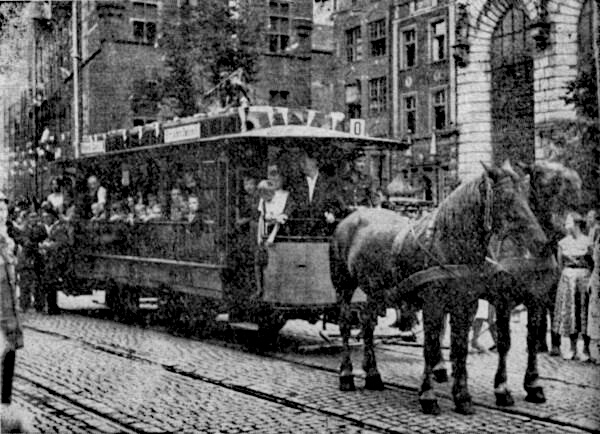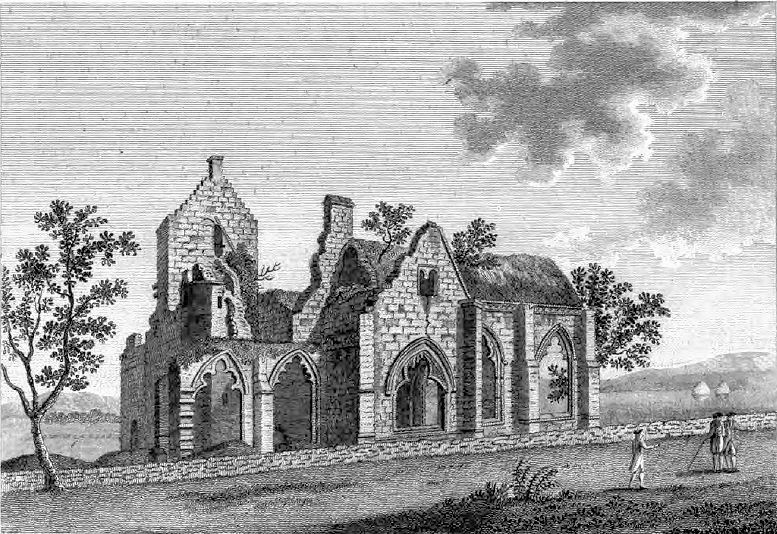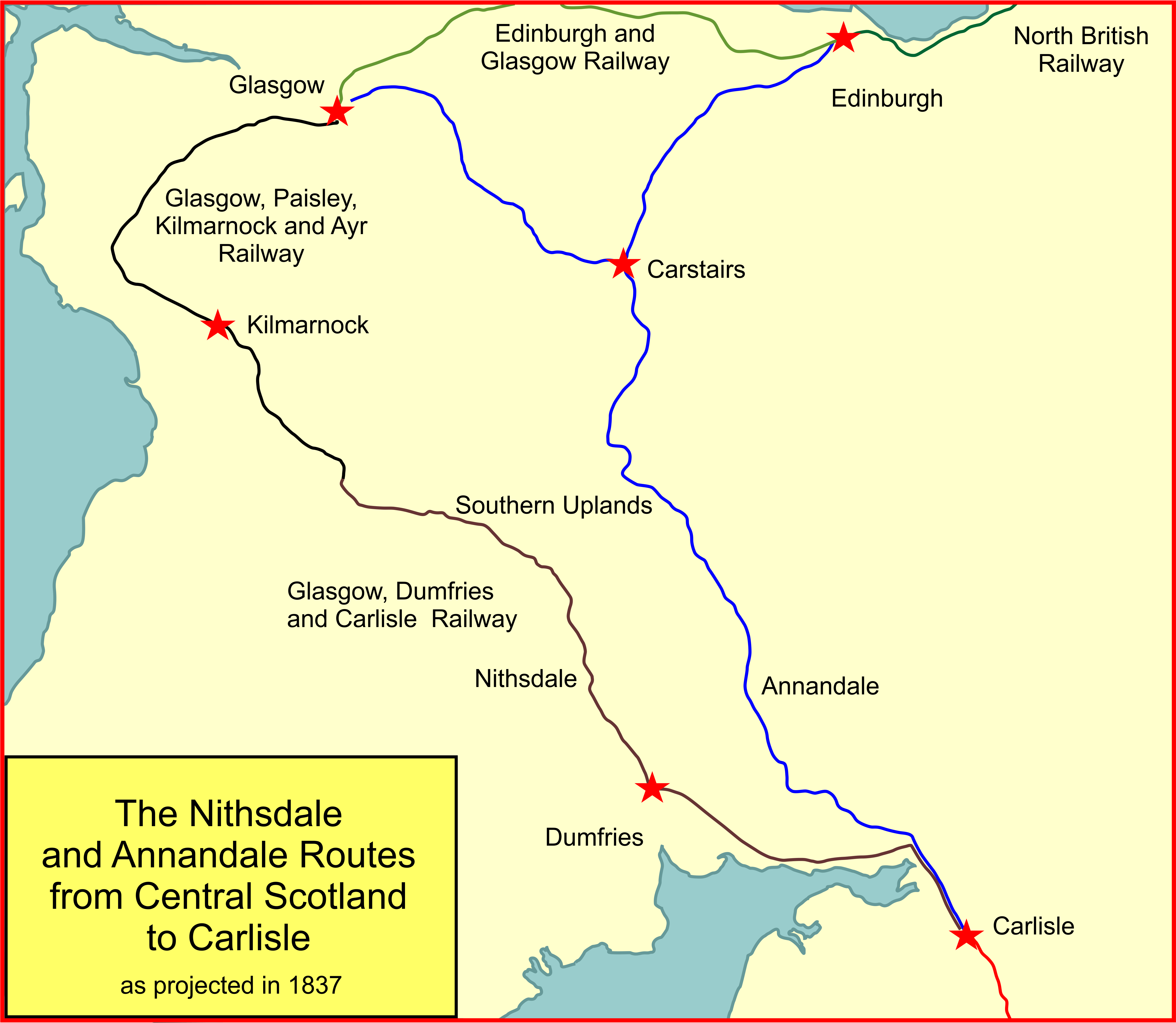|
Port Carlisle Railway
There were two interlinked railways on the south shore of the Solway Firth. The Port Carlisle Dock and Railway Company was opened in 1854, following the route of a former canal, intended to connect Port Carlisle, to which sea-going ships could navigate, with the city of Carlisle. The Carlisle and Silloth Bay Railway and Dock Company was built as an extension of the Port Carlisle line, opening in 1856, because silting of the Solway was making Port Carlisle unusable. The two railways operated collaboratively, but neither was successful financially and insolvency seemed inevitable. However the North British Railway (NBR) was building the line that became the Waverley Route from Edinburgh to Carlisle. The established railways at Carlisle obstructed the NBR's intended access, so the NBR leased the Port Carlisle and the Silloth companies, and connected with them at the Port Carlisle's station in Carlisle. The NBR sent goods traffic for English destinations on to Silloth and by coasta ... [...More Info...] [...Related Items...] OR: [Wikipedia] [Google] [Baidu] |
Horse-drawn Vehicle
A horse-drawn vehicle is a mechanized piece of equipment pulled by one horse or by a team of horses. These vehicles typically had two or four wheels and were used to carry passengers and/or a load. They were once common worldwide, but they have mostly been replaced by automobiles and other forms of self-propelled transport. General Horses were domesticated circa 3500 BCE. Prior to that oxen were used. Historically a wide variety of arrangements of horses and vehicles have been used, from chariot racing, which involved a small vehicle and four horses abreast, to horsecars or trollies, which used two horses to pull a car that was used in cities before electric trams were developed. A two-wheeled horse-drawn vehicle is a cart (see various types below, both for carrying people and for goods). Four-wheeled vehicles have many names – one for heavy loads is most commonly called a wagon. Very light carts and wagons can also be pulled by donkeys (much smaller than horses), pony, po ... [...More Info...] [...Related Items...] OR: [Wikipedia] [Google] [Baidu] |
Newcastle And Carlisle Railway
The Newcastle & Carlisle Railway (N&CR) was an English railway company formed in 1825 that built a line from Newcastle upon Tyne on Britain's east coast, to Carlisle, on the west coast. The railway began operating mineral trains in 1834 between Blaydon and Hexham, and passengers were carried for the first time the following year. The rest of the line opened in stages, completing a through route between Carlisle and Gateshead, south of the River Tyne in 1837. The directors repeatedly changed their intentions for the route at the eastern end of the line, but finally a line was opened from Scotswood to a Newcastle terminal in 1839. That line was extended twice, reaching the new Newcastle Central Station in 1851. A branch line was built to reach lead mines around Alston, opening from Haltwhistle in 1852. For many years the line ran trains on the right-hand track on double line sections. In 1837 a station master on the line, Thomas Edmondson, introduced pre-printed numbered pasteboa ... [...More Info...] [...Related Items...] OR: [Wikipedia] [Google] [Baidu] |
National Railway Museum
The National Railway Museum is a museum in York forming part of the Science Museum Group. The museum tells the story of rail transport in Britain and its impact on society. It is the home of the national collection of historically significant railway vehicles such as LNER Class A4 4468 Mallard, Mallard, GNR Stirling 4-2-2, Stirling Single, LMS Princess Coronation Class 6229 Duchess of Hamilton, Duchess of Hamilton and a Japanese Shinkansen, bullet train. In addition, the National Railway Museum holds a diverse collection of other objects, from a household recipe book used in George Stephenson's house to film showing a "People mover, never-stop railway" developed for the British Empire Exhibition. It has won many awards, including the European Museum of the Year Award in 2001. the museum is about to embark on a major site development. As part of the York Central redevelopment which will divert Leeman Road, the National Railway Museum will be building a new entrance building to c ... [...More Info...] [...Related Items...] OR: [Wikipedia] [Google] [Baidu] |
Port Carlisle Dandy
A port is a maritime facility comprising one or more wharves or loading areas, where ships load and discharge cargo and passengers. Although usually situated on a sea coast or estuary, ports can also be found far inland, such as Hamburg, Manchester and Duluth; these access the sea via rivers or canals. Because of their roles as ports of entry for immigrants as well as soldiers in wartime, many port cities have experienced dramatic multi-ethnic and multicultural changes throughout their histories. Ports are extremely important to the global economy; 70% of global merchandise trade by value passes through a port. For this reason, ports are also often densely populated settlements that provide the labor for processing and handling goods and related services for the ports. Today by far the greatest growth in port development is in Asia, the continent with some of the world's largest and busiest ports, such as Singapore and the Chinese ports of Shanghai and Ningbo-Zhou ... [...More Info...] [...Related Items...] OR: [Wikipedia] [Google] [Baidu] |
Caledonian Railway
The Caledonian Railway (CR) was a major Scottish railway company. It was formed in the early 19th century with the objective of forming a link between English railways and Glasgow. It progressively extended its network and reached Edinburgh and Aberdeen, with a dense network of branch lines in the area surrounding Glasgow. It was absorbed into the London, Midland and Scottish Railway in 1923. Many of its principal routes are still used, and the original main line between Carlisle and Glasgow is in use as part of the West Coast Main Line railway (with a modified entry into Glasgow itself). Introduction In the mid-1830s, railways in England evolved from local concerns to longer routes that connected cities, and then became networks. In Scotland it was clear that this was the way forward, and there was a desire to connect the Central Belt to the incipient English network. There was controversy over the route that such a line might take, but the Caledonian Railway was formed on ... [...More Info...] [...Related Items...] OR: [Wikipedia] [Google] [Baidu] |
Port Carlisle Map
A port is a maritime facility comprising one or more wharves or loading areas, where ships load and discharge cargo and passengers. Although usually situated on a sea coast or estuary, ports can also be found far inland, such as Hamburg, Manchester and Duluth; these access the sea via rivers or canals. Because of their roles as ports of entry for immigrants as well as soldiers in wartime, many port cities have experienced dramatic multi-ethnic and multicultural changes throughout their histories. Ports are extremely important to the global economy; 70% of global merchandise trade by value passes through a port. For this reason, ports are also often densely populated settlements that provide the labor for processing and handling goods and related services for the ports. Today by far the greatest growth in port development is in Asia, the continent with some of the world's largest and busiest ports, such as Singapore and the Chinese ports of Shanghai and Ningbo-Zhou ... [...More Info...] [...Related Items...] OR: [Wikipedia] [Google] [Baidu] |
William Lowther, 2nd Earl Of Lonsdale
William Lowther, 2nd Earl of Lonsdale, PC, FRS (21 July 1787 – 4 March 1872), styled Viscount Lowther between 1807 and 1844, was a British Tory politician. Background Lonsdale was the eldest son of William Lowther, 1st Earl of Lonsdale, and Lady Augusta, daughter of John Fane, 9th Earl of Westmorland. Henry Lowther was his younger brother. He was educated at Harrow and Trinity College, Cambridge. Political career Lonsdale was returned to parliament for Cockermouth in 1808, a seat he held until 1813, and later represented Westmorland between 1813 and 1831 and 1832 and 1841, Dunwich in 1832 and West Cumberland between 1832 and 1833. He was sworn of the Privy Council in 1818 and served under the Duke of Wellington as First Commissioner of Woods and Forests between 1828 and 1830 and under Sir Robert Peel as Treasurer of the Navy and Vice-President of the Board of Trade between 1834 and 1835. In 1841 he was summoned to the House of Lords through a writ of acceleration in his f ... [...More Info...] [...Related Items...] OR: [Wikipedia] [Google] [Baidu] |
Annan, Dumfries And Galloway
Annan ( ; gd, Inbhir Anainn) is a town and former royal burgh in Dumfries and Galloway, south-west Scotland. Historically part of Dumfriesshire, its public buildings include Annan Academy, of which the writer Thomas Carlyle was a pupil, and a Georgian building now known as "Bridge House". Annan also features a Historic Resources Centre. In Port Street, some of the windows remain blocked up to avoid paying the window tax. Each year on the first Saturday in July, Annan celebrates the Royal Charter and the boundaries of the Royal Burgh are confirmed when a mounted cavalcade undertakes the Riding of the Marches. Entertainment includes a procession, sports, field displays and massed pipe bands. Annan's in America first migrated to New York and Virginia. Annandale Virginia is an early settlement which celebrates The Scottish Games annually. Geography Annan stands on the River Annan—from which it is named—nearly from its mouth, accessible to vessels of 60 tons as far as ... [...More Info...] [...Related Items...] OR: [Wikipedia] [Google] [Baidu] |
Dumfries
Dumfries ( ; sco, Dumfries; from gd, Dùn Phris ) is a market town and former royal burgh within the Dumfries and Galloway council area of Scotland. It is located near the mouth of the River Nith into the Solway Firth about by road from the Anglo-Scottish border and just away from Cumbria by air. Dumfries is the county town of the historic county of Dumfriesshire. Before becoming King of Scots, Robert the Bruce killed his rival the Red Comyn at Greyfriars Kirk in the town on 10 February 1306. The Young Pretender had his headquarters here during a 3-day sojourn in Dumfries towards the end of 1745. During the Second World War, the bulk of the Norwegian Army during their years in exile in Britain consisted of a brigade in Dumfries. Dumfries is nicknamed ''Queen of the South''. This is also the name of the town's professional football club. People from Dumfries are known colloquially in Scots language as ''Doonhamers''. Toponymy There are a number of theories on the etymo ... [...More Info...] [...Related Items...] OR: [Wikipedia] [Google] [Baidu] |
Glasgow, Dumfries And Carlisle Railway
The Glasgow, Dumfries and Carlisle Railway was a railway company in Scotland, which constructed the line from near Cumnock to Gretna Junction, forming the route from Glasgow to Carlisle via Dumfries, in association with other lines. Its promoters hoped it would form the only railway between central Scotland and England, but it lost out to rival companies. It opened in stages between 1846 and 1850, and on completion of its line it merged with the Glasgow, Paisley, Kilmarnock and Ayr Railway. The combined company took the name Glasgow & South Western Railway (G&SWR). The G&SWR formed an alliance with the English Midland Railway and for many years express passenger trains ran between Glasgow and London over the routes. The line is open today, continuing to form part of the Glasgow - Kilmarnock - Dumfries - Carlisle line; but that has diminished in importance and is now a secondary route. Passenger services are operated by ScotRail. History A line into Ayrshire, and later to En ... [...More Info...] [...Related Items...] OR: [Wikipedia] [Google] [Baidu] |
Lancaster And Carlisle Railway
The Lancaster and Carlisle Railway was a main line railway opened between those cities in 1846. With its Scottish counterpart, the Caledonian Railway, the Company launched the first continuous railway connection between the English railway network and the emerging network in central Scotland. The selection of its route was controversial, and strong arguments were put forward in favour of alternatives, in some cases avoiding the steep gradients, or connecting more population centres. Generating financial support for such a long railway was a challenge, and induced the engineer Joseph Locke to make a last-minute change to the route: in the interests of economy and speed of construction, he eliminated a summit tunnel at the expense of steeper gradients. The sparseness of the population discouraged the addition of branch lines, with a small number of exceptions, although several east-west secondary routes made independent connection to the route. Establishing a joint station at Carlis ... [...More Info...] [...Related Items...] OR: [Wikipedia] [Google] [Baidu] |


.jpg)








